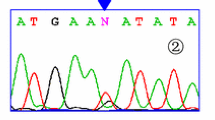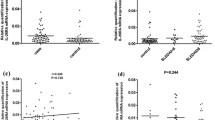Abstract
Background
Studies have indicated the involvement of interleukin (IL)-33 in the pathogenesis of Systemic lupus erythematosus (SLE). This research intended to evaluate the association of IL33 gene rs1929992 and rs7044343 Single nucleotide polymorphisms (SNPs) with risk of SLE. In addition, the association between these SNPs and inflammatory cytokines was determined.
Methods
In this study, 200 SLE cases and 200 healthy subjects were recruited. Using allelic discrimination Real-time PCR, IL33 gene rs1929992 and rs7044343 SNPs were genotyped. The mRNA expression levels of IL-1β, IL-6, IL-33, TNF-α were determined in the peripheral blood mononuclear cells (PBMCs). The serum levels of cytokines were also measured.
Results
The G allele (OR = 1.57, CI: 1.18–2.08, P = 0.0017), GG genotype (OR = 2.52, CI: 1.33–4.77, P = 0.0043), and GA genotype (OR = 2.12, CI: 1.34–3.34, P = 0.0011) of rs1929992 SNP was significantly associated with an increased SLE risk. The C allele (OR = 1.44, CI: 1.08-1.90; P = 0.0105), CC genotype (OR = 2.07, CI: 1.15-3.71; P = 0.0146), and CT genotype (OR = 1.61, CI: 1.02-2.53, P = 0.0395) of rs7044343 was significantly associated with increased SLE risk. The PBMC mRNA expression and serum levels of IL-1β, IL-6, IL-33, TNF-α were significantly increased in the SLE patients compared to controls. However, there was no significant difference in the mRNA expression and serum levels of IL-1β, IL-6, IL-33, and TNF-α among the SLE patients with three genotypes for both rs1929992 and rs7044343 polymorphisms.
Conclusions
IL33 gene rs1929992 and rs7044343 SNPs are involved in SLE pathogenesis but they might not influence on the inflammatory pathway.
Key Points • The alleles and genotypes of IL33 gene rs1929992 and rs7044343 SNPs were significantly associated with an increased SLE risk. • The mRNA expression and serum levels of IL-1β, IL-6, IL-33, TNF-α were significantly increased in the SLE patients compared to controls. • There was no significant association of mRNA expression and serum levels of inflammatory cytokines with IL33 SNPs in the SLE patients. |


Similar content being viewed by others
Data availability
All data that support the conclusions of this manuscript are included within the article.
References
Trentin F, Zucchi D, Signorini V et al (2021) One year in review 2021: systemic lupus erythematosus. Clin Exp Rheumatol 39:231–41. https://doi.org/10.55563/clinexprheumatol/7gzsxp
Tsokos GC, Lo MS, Reis PC et al (2016) New insights into the immunopathogenesis of systemic lupus erythematosus. Nat Rev Rheumatol 12:716–730. https://doi.org/10.1038/nrrheum.2016.186
Fathollahi A, Gabalou N, Aslani S (2018) Mesenchymal stem cell transplantation in systemic lupus erythematous, a mesenchymal stem cell disorder. Lupus 27:1053–1064. https://doi.org/10.1177/0961203318768889
Javinani A, Ashraf-Ganjouei A, Aslani S et al (2019) Exploring the etiopathogenesis of systemic lupus erythematosus: a genetic perspective. Immunogenetics 71:283–297. https://doi.org/10.1007/s00251-019-01103-2
Foma AM, Aslani S, Karami J et al (2017) Epigenetic involvement in etiopathogenesis and implications in treatment of systemic lupus erythematous. Inflamm Res 66:1057–1073. https://doi.org/10.1007/s00011-017-1082-y
Salmaninejad A, Mahmoudi M, Aslani S et al (2017) Association of STAT4 gene single nucleotide polymorphisms with Iranian juvenile-onset systemic lupus erythematosus patients. Turkish J Pediatr 59:144–9. https://doi.org/10.24953/turkjped.2017.02.005
Ebrahimiyan H, Rezaei R, Mostafaei S et al (2018) Association study between STAT4 polymorphisms and susceptibility to systemic lupus erythematosus disease: A systematic review and meta-analysis. Meta Gene 16:241–247. https://doi.org/10.1016/j.mgene.2018.03.010
Mahmoudi M, Aslani S, Hamzeh E et al (2017) Association study of MECP2 gene single nucleotide polymorphisms in juvenile-onset systemic lupus erythematosus patients from Iran. Fetal Pediatr Pathol 36:423–431. https://doi.org/10.1080/15513815.2017.1367871
Ebrahimiyan H, Mostafaei S, Aslani S et al (2022) Association between complement gene polymorphisms and systemic lupus erythematosus: a systematic review and meta-analysis. Clin Exp Med. 22(3):427–438. https://doi.org/10.1007/s10238-021-00758-0
Drake LY, Kita H (2017) IL-33: biological properties, functions, and roles in airway disease. Immunol Rev 278:173–184. https://doi.org/10.1111/imr.12552
Pinto SM, Subbannayya Y, Rex D et al (2018) A network map of IL-33 signaling pathway. J Cell Commun Signal 12:615–624. https://doi.org/10.1007/s12079-018-0464-4
Cho KA, Suh JW, Sohn JH et al (2012) IL-33 induces Th17-mediated airway inflammation via mast cells in ovalbumin-challenged mice. Am J Physiol Lung Cell Mol Physiol 302:L429–L440. https://doi.org/10.1152/ajplung.00252.2011
Smith DE (2010) IL-33: a tissue derived cytokine pathway involved in allergic inflammation and asthma. Clin Exp Allergy 40:200–208. https://doi.org/10.1111/j.1365-2222.2009.03384.x
Ramezani F, Babaie F, Aslani S et al (2022) The role of the IL-33/ST2 immune pathway in autoimmunity: new insights and perspectives. Immunol Invest. 51(4):1060–1086. https://doi.org/10.1080/08820139.2021.1878212
Italiani P, Manca ML, Angelotti F et al (2018) IL-1 family cytokines and soluble receptors in systemic lupus erythematosus. Arthritis Res Ther 20:27. https://doi.org/10.1186/s13075-018-1525-z
Guo C, Zhou M, Zhao S et al (2019) Innate lymphoid cell disturbance with increase in ILC1 in systemic lupus erythematosus. Clin Immunol 202:49–58. https://doi.org/10.1016/j.clim.2019.03.008
Mok MY, Huang FP, Ip WK et al (2010) Serum levels of IL-33 and soluble ST2 and their association with disease activity in systemic lupus erythematosus. Rheumatology (Oxford) 49:520–527. https://doi.org/10.1093/rheumatology/kep402
Zhu X, Xie L, Qin H et al (2019) Interaction between IL-33 Gene Polymorphisms and Current Smoking with Susceptibility to Systemic Lupus Erythematosus. J Immunol Res 2019:1547578. https://doi.org/10.1155/2019/1547578
Guo J, Xiang Y, Peng YF et al (2016) The association of novel IL-33 polymorphisms with sIL-33 and risk of systemic lupus erythematosus. Mol Immunol 77:1–7. https://doi.org/10.1016/j.molimm.2016.07.001
Xu W, Liu Y, Ye D (2016) Association between IL-33 Gene Polymorphisms (rs1929992, rs7044343) and Systemic Lupus Erythematosus in a Chinese Han Population. Immunol Invest 45:575–583. https://doi.org/10.1080/08820139.2016.1193868
Hochberg MC (1997) Updating the American College of Rheumatology revised criteria for the classification of systemic lupus erythematosus. Arthritis Rheum 40:1725. https://doi.org/10.1002/art.1780400928
Gladman DD, Ibanez D, Urowitz MB (2002) Systemic lupus erythematosus disease activity index 2000. J Rheumatol 29:288–291
Roe BA, Crabtree JS, Khan AS (1996) DNA isolation and sequencing. Wiley
Untergasser A, Nijveen H, Rao X et al (2007) Primer3Plus, an enhanced web interface to Primer3. Nucleic Acids Res 35:W71–W74. https://doi.org/10.1093/nar/gkm306
Schmittgen TD, Livak KJ (2008) Analyzing real-time PCR data by the comparative CT method. Nat protoc 3:1101–1108. https://doi.org/10.1038/nprot.2008.73
Yong Y, Lin H (2005) SHEsis, a powerful software platform for analyses of linkage disequilibrium, haplotype construction, and genetic association at polymorphism loci. Cell Res 15:97–98. https://doi.org/10.1038/sj.cr.7290272
Yang Z, Liang Y, Xi W et al (2011) Association of increased serum IL-33 levels with clinical and laboratory characteristics of systemic lupus erythematosus in Chinese population. Clin Exp Med 11:75–80. https://doi.org/10.1007/s10238-010-0115-4
Brugos B, Vincze Z, Sipka S et al (2012) Serum and urinary cytokine levels of SLE patients. Pharmazie 67:411–413
Mok MY, Huang FP, Ip WK et al (2010) Serum levels of IL-33 and soluble ST2 and their association with disease activity in systemic lupus erythematosus. Rheumatology 49:520–527. https://doi.org/10.1093/rheumatology/kep402
Li P, Lin W, Zheng X (2014) IL-33 neutralization suppresses lupus disease in lupus-prone mice. Inflammation 37:824–832. https://doi.org/10.1007/s10753-013-9802-0
Carneiro JR, Fuzii HT, Kayser C et al (2011) IL-2, IL-5, TNF-α and IFN-γ mRNA expression in epidermal keratinocytes of systemic lupus erythematosus skin lesions. Clinics 66:77–82. https://doi.org/10.1590/s1807-59322011000100014
López-Mejías R, Genre F, Remuzgo-Martínez S et al (2015) Protective Role of the Interleukin 33 rs3939286 Gene Polymorphism in the Development of Subclinical Atherosclerosis in Rheumatoid Arthritis Patients. PLoS One 10:e0143153. https://doi.org/10.1371/journal.pone.0143153
Li C, Mu R, Guo J et al (2014) Genetic variant in IL33 is associated with susceptibility to rheumatoid arthritis. Arthritis Res Ther 16:1–10. https://doi.org/10.1186/ar4554
Koca SS, Pehlivan Y, Kara M et al (2016) The IL-33 gene is related to increased susceptibility to systemic sclerosis. Rheumatol Int 36:579–584. https://doi.org/10.1007/s00296-015-3417-8
Koca SS, Kara M, Deniz F et al (2015) Serum IL-33 level and IL-33 gene polymorphisms in Behçet’s disease. Rheumatol Int 35:471–477. https://doi.org/10.1007/s00296-014-3111-2
Xu W, Liu Y, Ye D (2016) Association between IL-33 gene polymorphisms (rs1929992, rs7044343) and systemic lupus erythematosus in a Chinese Han population. Immunol Invest 45:575–583. https://doi.org/10.1080/08820139.2016.1193868
Fan D, Ding N, Yang T et al (2014) Single nucleotide polymorphisms of the interleukin-33 (IL-33) gene are associated with ankylosing spondylitis in Chinese individuals: a case-control pilot study. Scand J Rheumatol 43:374–379. https://doi.org/10.3109/03009742.2014.882408
Zhu X, Xie L, Qin H et al (2019) Interaction between IL-33 gene polymorphisms and current smoking with susceptibility to systemic lupus erythematosus. J Immunol Res 2019:1547578. https://doi.org/10.1155/2019/1547578
Acknowledgements
The authors are grateful of the patients for their participation in this study.
Funding
This article was supported by a grant from Deputy of Research, Rafsanjan University of Medical Sciences.
Author information
Authors and Affiliations
Contributions
Zahra Bagheri-Hosseinabadi performed experiments, participated in manuscript writing, and read the manuscript critically. Mohammad Reza Mirzaei participated in performing experiments, performed statistical analysis, participated in manuscript writing, and read the manuscript critically. Mina Aliakbari participated in performing experiments, performed statistical analysis, participated in manuscript writing, and read the manuscript critically. Mitra Abbasifard developed the main idea, participated in study conceptualization, participated in manuscript writing, and read the manuscript critically.
Corresponding author
Ethics declarations
Ethics approval and consent to participate
This study was approved by the ethics committee of Rafsanjan University of Medical Sciences (IR.RUMS.REC.1400.172) and all individuals voluntarily signed a written informed consent form. All methods were performed in accordance with the relevant guidelines and regulations by Rafsanjan University of Medical Sciences.
Consent for publication
Not applicable.
Disclosures
None.
Additional information
Publisher's note
Springer Nature remains neutral with regard to jurisdictional claims in published maps and institutional affiliations.
Rights and permissions
Springer Nature or its licensor (e.g. a society or other partner) holds exclusive rights to this article under a publishing agreement with the author(s) or other rightsholder(s); author self-archiving of the accepted manuscript version of this article is solely governed by the terms of such publishing agreement and applicable law.
About this article
Cite this article
Bagheri-Hosseinabadi, Z., Mirzaei, M.R., Aliakbari, M. et al. Association of interleukin 33 gene polymorphisms with susceptibility and regulation of inflammatory mediators in Systemic lupus erythematosus patients. Clin Rheumatol 42, 2187–2197 (2023). https://doi.org/10.1007/s10067-023-06575-y
Received:
Revised:
Accepted:
Published:
Issue Date:
DOI: https://doi.org/10.1007/s10067-023-06575-y




